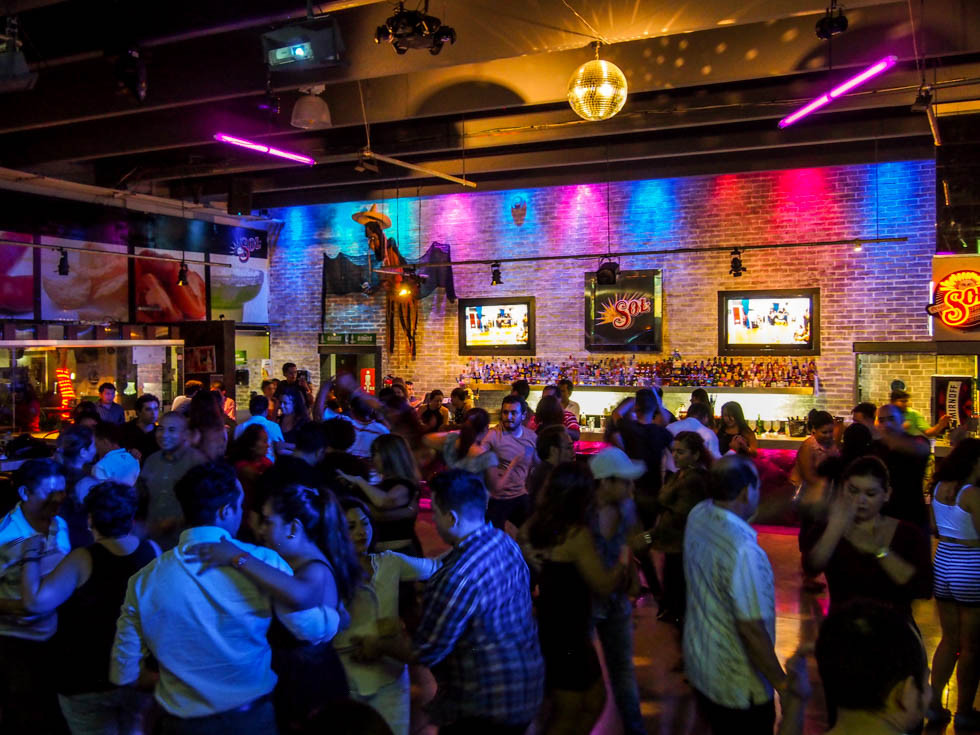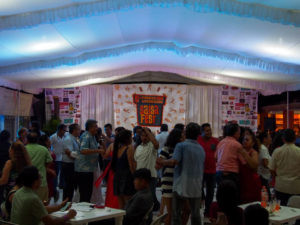Mexico, a country celebrated for its vibrant culture and passionate spirit, is also a haven for dancers. If you’re a dance enthusiast planning a trip, or simply curious about the dance scene, Mexico offers a rich tapestry of rhythms and movements waiting to be explored. From the energetic beats of salsa to the sensual flows of bachata, and the lively steps of cumbia, Mexico’s dance floors are alive with diverse styles and welcoming communities. This guide will take you through some of the best cities and venues for Dancers In Mexico, ensuring you find your rhythm in this captivating country.
 Full dance floor at Mérida’s Sunday social at Las de Guanatos restaurant
Full dance floor at Mérida’s Sunday social at Las de Guanatos restaurant
For many travelers, dance is more than just a pastime; it’s a way to connect with new cultures and people. Exploring local dance scenes offers a unique window into the heart of a destination. In Mexico, dance is woven into the social fabric, offering countless opportunities to immerse yourself in local life and connect with fellow dancers. Whether you are a seasoned salsa pro or a beginner eager to learn, Mexico’s dance communities are ready to embrace you.
General Insights into Mexican Dance Culture
When you step onto a dance floor in Mexico, you’ll likely encounter a blend of salsa styles, primarily “en línea” and Cuban salsa. “En línea,” or linear salsa, encompasses Salsa On 1 and Salsa On 2. While both exist, Salsa On 1 tends to be more prevalent in social settings and clubs. Cuban salsa is also widely danced and taught in many establishments. For dancers looking to fully enjoy the Mexican salsa scene, familiarity with both styles is advantageous.
Beyond salsa, Mexican dance venues resonate with a variety of Latin rhythms. Salsa dominates most nights, often accompanied by live bands. However, bachata, typically urban or sensual bachata, is also popular. Cumbia holds a significant place, and you might hear hints of cha-cha-cha. Merengue, though less common, occasionally makes an appearance.
Across Mexico, a strong dance community spirit thrives. Even smaller cities usually have active dance scenes, particularly on Friday and Saturday nights. Larger cities boast daily dance opportunities, sometimes with multiple venues to choose from each night. Guadalajara stands out as a favorite for many dancers, known for its impressive venues, welcoming community, and high caliber of dancers.
Now, let’s explore specific cities and venues where you can experience the vibrant dance culture of Mexico. Remember that dance scenes can evolve, so it’s always a good idea to double-check information and ask locals for the most up-to-date recommendations.
Mexico City: A Metropolis of Movement
Mexico City, a sprawling metropolis, offers a diverse and dynamic dance scene to match its urban energy.
Pata Negra: A Mexico City classic, Pata Negra hosts salsa nights on Wednesdays and Saturdays. The Wednesday social is particularly popular, featuring free salsa classes for all levels (beginner, intermediate, advanced) followed by social dancing. The night progresses from DJ sets to live salsa music, transitioning into a general club atmosphere after midnight. Before then, it’s a fantastic salsa social with a friendly vibe and dancers of all levels. The wooden dance floor, while often crowded, is worth experiencing.
Bachata Mexico: As the name suggests, Bachata Mexico is a dance studio specializing in bachata, but also offering Cuban salsa. On Thursday nights, they host a social after workshops, offering a mix of salsa and bachata dancing until midnight. This is a prime spot for bachata dancers in Mexico City. There’s a fee for classes and a cover charge for the social, often included in the workshop price.
Mama Rumba: Known for its authentic Cuban salsa experience, Mama Rumba is open several nights a week with a cover charge. While it’s a great place to enjoy live Cuban music, the dance space is more like wide aisles than a dedicated dance floor, which can become very crowded, especially during special events.
Nuevo Foro Hilvana: Foro Hilvana is a recommended venue for Friday night socials. Arrive early for free entry before the cover charge starts around 8:30 PM. They offer a salsa class before the social, which features a live band and a lively mix of dancers. The dance floor is spacious and smooth, making it a great place to dance.
Fusion Salsa Fest: If your trip coincides with October, consider attending Fusion Salsa Fest (FSF), Mexico City’s salsa congress. This large event features workshops, performances, and social dancing. Workshops can be very crowded, but the Saturday night party is a highlight, lasting until the early hours with live salsa bands and separate rooms for salsa and bachata/kizomba. It attracts high-level dancers and is a significant event in the Mexican dance calendar.
https://www.instagram.com/p/BLWwsfQDZyQ/?taken-by=inlocamotion
A lively dance congress scene in Mexico City, showcasing the energy and passion of salsa dancers at a major dance event.
San Miguel de Allende: Dancing in a Picturesque Setting
San Miguel de Allende, a charming colonial city, offers a more intimate dance experience.
Bar La Chula: La Chula offers live salsa music on Wednesday nights. While San Miguel’s dance scene is generally more active Thursday through Saturday, La Chula provides a mid-week option. It’s a smaller venue with a compact dance floor, but the covered terrace location provides stunning nighttime views of San Miguel de Allende. It’s more suitable for enjoying music and dancing casually with friends rather than a dedicated social dance event.
Guanajuato: A Welcoming Scene in a Colonial City
Guanajuato, another beautiful colonial city, has a welcoming dance community.
La dama de las camelias: La Dama de las Camelias is a bar that becomes a salsa spot, open Thursday, Friday, and Saturday. It can be a hit or miss depending on the crowd, sometimes attracting more general partiers than dedicated social dancers. However, the local salsa community often gathers here, creating a friendly atmosphere. Thursday nights are generally less crowded than Fridays. There’s a small cover charge, and the music is primarily DJ-driven salsa, with occasional bachata and cumbia sets.
El Guaguancó: While not visited in the original article, El Guaguancó was mentioned as an upcoming venue with a promising dance floor. It may now be a central spot in Guanajuato’s dance scene and worth checking out for a potentially dedicated dance environment.
Guadalajara: The Heart of Mexican Salsa
Guadalajara is highlighted as a top city for salsa dancing in Mexico, boasting vibrant and welcoming venues.
Chapultepec Salsero: A unique and free Monday night social, Chapultepec Salsero takes place outdoors on the pedestrian walkway of Avenida Chapultepec. It starts early with a free class at 6:30 PM, followed by open dancing. The expansive outdoor “dance floor” along the median offers ample space, and the community is known for its welcoming nature. This social happens rain or shine, a testament to the dedication of Guadalajara dancers.
https://www.instagram.com/p/BLsTIRzjrvt/?taken-by=inlocamotion
Outdoor salsa dancing at Chapultepec Salsero in Guadalajara, Mexico, capturing the open-air and community-focused dance event.
Hotel Riu: The Hotel Riu in Guadalajara hosts salsa in its lobby every Tuesday and Friday. There’s a free salsa class from 9:00 to 10:00 PM, followed by social dancing with a live salsa band. There’s no cover charge, making it an accessible and popular option. The dance floor can get crowded, but the atmosphere is lively.
Gran Salon Corona: Gran Salon Corona is a standout venue, considered a favorite in Mexico. Open Thursdays and Fridays, it features a massive, slick dance floor, two live salsa bands, and significant bachata sets between band performances. There’s no cover before 11:00 PM, and a salsa class is offered before the social. It’s known for playing a good mix of salsa and bachata, attracting a large crowd of enthusiastic dancers.
Bailamos salsa en GDL Facebook page: For more up-to-date information on Guadalajara’s active dance scene, check the Facebook page “Bailamos salsa en GDL.” It provides details on various socials and events, especially for Fridays and Saturdays.
Morelia: Historic Charm and Dance Rhythms
Morelia, with its beautiful historic center, offers dance options with a local flavor.
La Porfiriana: Despite mixed reviews from local dancers, La Porfiriana can be a worthwhile experience, especially for visitors in the historic center. Open multiple nights a week, it features a salsa class, followed by live band performances. The class was noted as being more ballroom salsa style. There is a table minimum, and the music is a mix of salsa and cumbia, with DJ sets including bachata. The dance floor is spacious and smooth.
Konkolo Snack Bar: Located outside the historic center, Konkolo is a larger venue that gets crowded quickly. Arriving early can avoid a cover charge. Open multiple nights, it features live bands and DJ sets, primarily playing salsa and cumbia with some bachata. Wednesday nights are often recommended by locals, but Thursday nights can also be enjoyable.
Puebla: A Sunday Salsa Highlight
Puebla offers a standout social, especially for those visiting on a Sunday.
Mambito’s Salsa Social: Mambito’s is described as a favorite dance social in Mexico. It occurs every other Sunday night, starting early and ending around midnight. There’s a small cover charge, and the music is DJ-driven, typically playing sets of salsa followed by bachata. The hardwood dance floor is spacious, and the social is known for attracting high-level dancers and a very welcoming community. Planning your Puebla visit around this social is highly recommended.
Oaxaca: Exploring a Southern Dance Scene
Oaxaca, known for its culture and cuisine, presents a more challenging salsa scene.
La Tentación: La Tentación, visited on a Wednesday, was found to be quiet. While playing Latin music (salsa, bachata, cumbia), it seemed to require bringing your own dance partner to truly enjoy. It’s unclear if other nights are more active. The dance floor is small, and there was no cover charge during the visit. It may be better for drinks and music rather than social dancing.
Restaurante Candela: Candela is often cited as “the” salsa venue in Oaxaca. However, a Thursday night visit revealed a crowded space where social dancing was difficult. The DJ played limited salsa and bachata, with more cumbia and reggaetón. While skilled salsa dancers were present, the community didn’t feel particularly welcoming on this occasion. The overall salsa scene in Oaxaca was considered less impressive compared to other cities.
Oaxaca Salsa Congress: Oaxaca hosts a salsa congress, potentially a better way to experience dancing in Oaxaca if your timing aligns. This larger event could offer a more vibrant and welcoming dance environment.
Puerto Escondido: Beachside Rhythms
Puerto Escondido, a coastal town, offers dance venues with a relaxed, beach vibe.
Playa Kabbalah: Kabbalah is Puerto Escondido’s Saturday night salsa spot, located right on Zicatela Beach. There’s no cover, and a live band plays salsa, cumbia, and some bachata. While the venue gets crowded, it’s often filled with partiers rather than dedicated social dancers. Salsa dancing can be challenging, but the beachside location is a unique perk. Later in the night, it transitions into a reggaetón club.
 Cumbia break! Live salsa and cumbia at the Puerto Escondido Salsa Fest
Cumbia break! Live salsa and cumbia at the Puerto Escondido Salsa Fest
Congo Bar: Congo Bar is a Wednesday and Friday dance venue in Puerto Escondido. A Wednesday night visit with a live band (during a special event) was enjoyable, with dancing spilling into the street. On regular nights, the setup may differ. The music is a mix of salsa and cumbia, and arriving earlier is recommended for salsa dancing before it becomes more of a party crowd later in the evening.
Puerto Escondido Salsa Fest: Puerto Escondido hosts a small salsa festival. This event includes workshops and parties on Friday and Saturday. The music is primarily salsa, with some cumbia, bachata, and quebradita. While the social dancing atmosphere at the festival was described as potentially cliquey by the original author, the organizer is seen as actively building the local dance community, making it a worthwhile event for dedicated dancers.
Playa del Carmen: Caribbean Coast Salsa
Playa del Carmen offers limited but notable salsa options on the Caribbean coast.
La Salsanera: La Salsanera is the main salsa venue found in Playa del Carmen. Open multiple days a week, it offers free salsa classes and often features live salsa bands. Arriving early can avoid a cover charge (starting around 10:30 PM). It has a nice wooden dance floor and is a solid option for salsa dancers in the area.
Mérida: Yucatán Rhythms
Mérida, in the Yucatán Peninsula, has a dance scene with its own unique flavor.
Mambo Cafe: Mambo Cafe is not recommended for social dancing. Described as a club with reggaetón, strobe lights, and a party atmosphere, it’s geared towards “perreo” style dancing rather than salsa or bachata despite advertising bachata nights. Live music is a fusion of salsa, cumbia, and reggaetón. It might appeal to those seeking a club experience but not social Latin dancing.
Astro Salsa: Astro Salsa, a dance school in Mérida, was previously known for organizing a great salsa/bachata social which is no longer running. However, Astro Salsa remains active with classes and socials. Checking their Facebook page for upcoming events is highly recommended. When the author visited their social, it was praised for its welcoming community and high level of dancing.
Conclusion:
Mexico is a vibrant and diverse country for dancers. From bustling metropolises like Mexico City and Guadalajara to charming colonial towns and beachside destinations, there are rhythms to discover and dance communities to join across the nation. While each city offers its own unique flavor, the common thread is the passion for dance and the welcoming spirit of Mexican dancers. Whether you’re seeking salsa, bachata, cumbia, or simply the joy of movement, Mexico’s dance floors are ready to embrace you. Explore these venues, connect with local dancers, and let the rhythms of Mexico move you.
Have you danced in Mexico? Share your favorite spots and experiences in the comments below! Your insights can help fellow dancers discover even more of Mexico’s rich dance scene.
